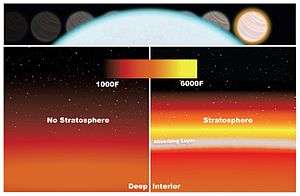WASP-33b
WASP-33b is an extrasolar planet orbiting the star HD 15082. It is the first planet discovered to orbit a Delta Scuti variable star. With a semimajor axis of 0.026 AU and a mass which is likely greater than Jupiter mass,[1] it belongs to the hot Jupiter class of planets.
| Discovery[1] | |
|---|---|
| Discovered by | WASP |
| Discovery date | 2010 |
| Transit | |
| Orbital characteristics | |
| 0.02555 ± 0.00017 AU (3,822,200 ± 25,432 km) [1] | |
| 1.21987089 ± 0.00000015 days (105,396.845 ± 0.013 s; 29.2769014 ± 3.6×10−6 h) [2] | |
| Inclination | 87.67±1.81°[1] |
| Semi-amplitude | 0.59 km/s (1,300 mph) [1] |
| Physical characteristics | |
Mean radius | 1.497±0.095 RJ[1] |
| Mass | 2.81±0.53 MJ[3] |
| Albedo | 0.369±0.050[3] |
| Temperature | 2,710 ± 50 K (2,440 ± 50.0 °C; 4,420 ± 90.0 °F) [1] |
Discovery
In 2010, the SuperWASP project announced the discovery of an extrasolar planet orbiting the star HD 15082. The discovery was made by detecting the transit of the planet as it passes in front of its star, an event which occurs every 1.22 days.
Orbit
The study in 2012, utilizing a Rossiter–McLaughlin effect, have determined the planetary orbit is strongly misaligned with the equatorial plane of the star, misalignment equal to -107.7±1.6°, making orbit of WASP-33b retrograde.[4]
Physical characteristics
Limits from radial velocity measurements imply it has less than 4.1 times the mass of Jupiter.[1] The exoplanet orbits so close to its star that its surface temperature is about 3,200 °C (5,790 °F).[5] The transit was later recovered in Hipparcos data.[6]
Atmosphere
June 2015 NASA reported the exoplanet has a stratosphere, and the atmosphere contains titanium oxide which creates the stratosphere. Titanium oxide is one of only a few compounds that is a strong absorber of visible and ultraviolet radiation, which heats the atmosphere, and able to exist in a gas state in a hot atmosphere.[7][8] The detection of temperature inversion (stratosphere), water and titanium oxide was disproved with the higher quality data obtained by 2020. Only upper limit of titanium oxide volume mixing rate equal to 1 ppb can be obtained.[9]

In 2020, with the detection of secondary eclipses (when the planet is blocked by its star), the mass of planet along with temperature profile across its surface was measured. The WASP-33b have a strong winds in its atmosphere similar to Venus, shifting hottest spot 28.7±7.1 degrees to the west. The illuminated side brightness temperature is 3014±60 K, while nightside brightness temperature is 1605±45 K.[3]
Non-Keplerian features of motion for HD 15082 b
In view of the high rotational speed of its parent star, the orbital motion of HD 15082 b may be affected in a measurable way by the huge oblateness of the star and effects of general relativity.
First, the distorted shape of the star makes its gravitational field deviate from the usual Newtonian inverse-square law. The same is true for the Sun, and part of the precession of the orbit of Mercury is due to this effect. However, it is estimated to be greater for HD 15082b.[10]
Other effects will also be greater for HD 15082b. In particular, precession due to general relativistic frame-dragging should be greater for HD 15082b than for Mercury, where it is so far too small to have been observed. It has been argued that the oblateness of HD 15082 could be measured at a percent accuracy from a 10-year analysis of the time variations of the planet's transits.[10] Effects due to the planet's oblateness are smaller by at least one order of magnitude, and they depend on the unknown angle between the planet's equator and the orbital plane, perhaps making them undetectable. The effects of frame-dragging are slightly too small to be measured by such an experiment.
References
- Collier Cameron, A.; et al. (2010). "Line-profile tomography of exoplanet transits - II. A gas-giant planet transiting a rapidly rotating A5 star". Monthly Notices of the Royal Astronomical Society. 407 (1): 507. arXiv:1004.4551. Bibcode:2010MNRAS.407..507C. doi:10.1111/j.1365-2966.2010.16922.x.
- Zhang, Michael; et al. (2017). "Phase curves of WASP-33b and HD 149026b and a New Correlation Between Phase Curve Offset and Irradiation Temperature". The Astronomical Journal. 155 (2): 83. arXiv:1710.07642. Bibcode:2018AJ....155...83Z. doi:10.3847/1538-3881/aaa458.
- von Essen, C.; Mallonn, M.; Borre, C. C.; Antoci, V.; Stassun, K. G.; Khalafinejad, S.; Tautvaivsiene, G. (2020). "TESS unveils the phase curve of WASP-33b. Characterization of the planetary atmosphere and the pulsations from the star". arXiv:2004.10767 [astro-ph.EP].
- Obliquities of Hot Jupiter host stars: Evidence for tidal interactions and primordial misalignments, 2012, arXiv:1206.6105
- "Hottest planet is hotter than some stars". Retrieved 2015-06-12.
- McDonald, I.; Kerins, E. (2018). "Pre-discovery transits of the exoplanets WASP-18b and WASP-33b from Hipparcos". Monthly Notices of the Royal Astronomical Society. 477 (1): L21. arXiv:1803.06187. Bibcode:2018MNRAS.477L..21M. doi:10.1093/mnrasl/sly045.
- "NASA's Hubble Telescope Detects 'Sunscreen' Layer on Distant Planet". 2015-06-11. Retrieved 2015-06-11.
- Haynes, Korey; Mandell, Avi M.; Madhusudhan, Nikku; Deming, Drake; Knutson, Heather (2015). "Spectroscopic Evidence for a Temperature Inversion in the Dayside Atmosphere of the Hot Jupiter WASP-33b". The Astrophysical Journal. 806 (2): 146. arXiv:1505.01490. Bibcode:2015ApJ...806..146H. doi:10.1088/0004-637X/806/2/146.
- A bot will complete this citation soon. Click here to jump the queue arXiv:2006.10743.
- Iorio, Lorenzo (2010-07-25), "Classical and relativistic node precessional effects in WASP-33b and perspectives for detecting them", Astrophysics and Space Science, 331 (2): 485–496, arXiv:1006.2707, Bibcode:2011Ap&SS.331..485I, doi:10.1007/s10509-010-0468-x